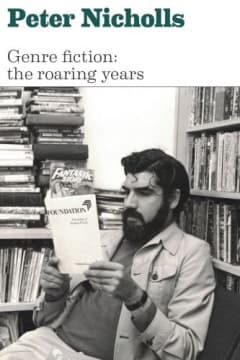
Genre Fiction: The Roaring Years by Peter Nicholls
(Ansible Editions, 2022)
Reviewed by Steven Doran
The package I received had 7 stamps stuck onto it: two Queen’s Heads, two miniature landscapes, a strawberry, an orange and a lemon. It was as if sending a package was as important as what it contained. That’s fitting, given Peter Nicholls’ care in bringing Sci-Fi to readers over his 57-year career, at the heart of which is The Encyclopedia of Science Fiction—a book first published in 1979 which is still updated today. This collection of reviews, essays, interviews, listicles and diaries covers publications from the 1970s up to the millennium. He chose them because they were his favourite pieces and because this period was a noisy and exciting time for Genre fiction.
The Roaring Years is a history told by an insider, observed both from the ‘salaried haven’ of academia and the ‘grubby frontline’ of publishing. He’s informed, incisive and honest, making a charming guide through the years when Wolfe, Dick, Aldiss and Herbert were bright young things, with many of their best-loved works yet to be written. There’s plenty more: essays on the state of the industry and the meaning of genre, lists of his 100 favourite writers (and 88 second favourites), and his own telling of The Great Tradition of Proto Science Fiction, covering Gilgamesh, Gawain, Rasselas and ‘The Rime of the Ancient Mariner’.
To set the scene, Nicholls provides journals from conventions. At Seacon in Coventry in 1975 and in Brighton in 1979, he recounts weekends spent talking in stairwells and not going to bed. Almost all of them drink too much and they aren’t given to politeness. There are awkward meetings with Sturgeon, Priest, Niven and Silverberg, though the Moorcock children behave like angels (if ‘rather damp ones’ who ‘with well-trained British masochism…spent half their time in the sea).
The first review is of Stanislaw Lem’s Solaris, a novel about extra-terrestrial intelligence in the form of a planet, written in Poland in 1961. Nicholls explains how Lem communicates a complex idea with simple but vibrant language, supported by generous examples. I hadn’t considered reading Solaris—assuming speculation on space travel from 60 years ago might have lost its spark. But Nicholls left me curious to investigate Lem for myself and I’m happy I did.
A writer’s craft, at sentence level, is Nicolls’ critical focus. Reviewing Ursula Le Guin’s just-published The Farthest Shore, he compares Le Guin’s description of death with comparable extracts from Tolkien and Dante and notes how she achieves a balance of grandeur, personability and wit. He also praises children’s author Susan Cooper for her skilful use of fantasy elements, giving ‘ballast of landscape and character…to keep wonder and menace from floating away,’ and he’s pleased to learn about how Diana Wynne Jones fought through an ‘enormous baffle of adults’ to publish her complex stories for children. This praise of children’s writers is consistent with Nicholls’ inclusive concept of genre: anyone’s welcome to take part who hasn’t been given a place in the mainstream. Following that, any assessment of a published work also takes into account the influences and demands of the market.
What Nicholls laments is laziness, whether in fiction, editing or historiography. David Kyle’s A Pictorial History of Science Fiction is charged with 14 instances of misinformation (in its first five pages) and its badly organised sentences create a ‘forest of grammatical stalactites’. Franz Rottensteiner’s Illustrated History of Science Fiction provides Nicholls with ‘no evidence that Rottensteiner himself is really interested.’
It’s clear Nicholls cares deeply about what he does, even if sometimes he presents with the irreverence of a Nick Hornby protagonist. In writing about writing, Nicholls provided something readers have as much appetite for as for the works themselves. SF stories are socialised from the start in magazines and anthologies, inviting comparison and conversation, and Stanislaw Lem’s A Perfect Vacuum, a collection of reviews about imaginary books, attests to writers’ fascination even with the forms and processes of criticism. We can access these conversations more easily now, with the internet, and so I’m left wondering about Nicholls’ writing post-2000. He lived and worked for another 18 years and I’m sure he had plenty to say.
Review from BSFA Review 19 - Download your copy here.
